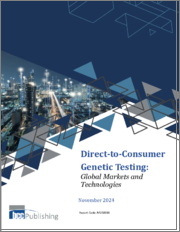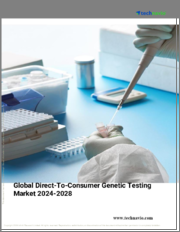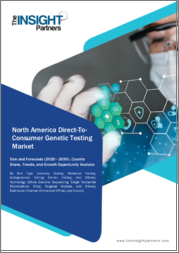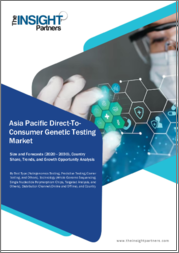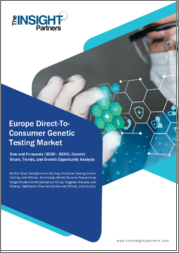
|
시장보고서
상품코드
1830303
소비자 직접 유전자 검사 시장 : 가계 검사, 건강 리스크 검사, 형질 검사, 영양 및 피트니스 검사, 약물유전체학 검사, 부자 관계 검사별 - 세계 예측(2025-2032년)Direct-to-Consumer Genetic Testing Market by Ancestry Testing, Health Risk Testing, Trait Testing, Nutritional And Fitness Testing, Pharmacogenomic Testing, Paternity Testing - Global Forecast 2025-2032 |
||||||
소비자 직접 유전자 검사 시장은 2032년까지 CAGR 17.70%로 87억 3,000만 달러로 성장할 것으로 예측됩니다.
| 주요 시장 통계 | |
|---|---|
| 기준 연도 2024년 | 23억 6,000만 달러 |
| 추정 연도 2025년 | 27억 9,000만 달러 |
| 예측 연도 2032 | 87억 3,000만 달러 |
| CAGR(%) | 17.70% |
소비자 수요, 기술 발전, 규제 당국의 기대가 어떻게 직접 소비자 유전자 검사 서비스를 재구성하고 있는지에 대한 명확하고 매력적인 방향성
소비자 직접 유전자 검사는 새로운 호기심에서 헬스케어, 웰니스, 소비자 기술의 교차점에서 전략적 채널로 진화했습니다. 소비자들은 현재 가계, 건강 위험, 형질, 영양, 약리유전체학을 일상적인 행동과 의료적 의사결정에 연결하는 실용적인 인사이트를 원하고 있습니다. 차세대 시퀀싱, 마이크로어레이 플랫폼, 클라우드 네이티브 분석의 기술 발전은 데이터 생성 속도와 세분성을 향상시키면서 샘플당 비용을 낮추고 개인화된 해석을 가능하게 하고 있습니다. 동시에 건강 문해력 향상, 원격의료 서비스 보급, 데이터 기반 셀프 케어에 대한 문화적 수용이 기존의 얼리어답터 외에도 수요를 확대시키고 있습니다.
소비자 직접 유전자 검사를 지원하는 상업적 생태계는 분석 개발자, 임상 실험실, 해석 소프트웨어 제공업체, E-Commerce 플랫폼, 제3자 통합업체 등 복잡하게 얽혀 있습니다. 각 이해관계자는 프라이버시와 데이터 보안을 보호하면서 사용자 경험, 임상적 타당성, 규제적 의무를 조화시켜야 합니다. 그 결과, 투명성 높은 커뮤니케이션, 임상의사 수준의 검증 경로, 의료 서비스 제공자와의 파트너십을 우선시하는 기업은 소비자의 관심을 지속적인 참여로 이어지게 할 수 있습니다. 앞으로도 이 분야는 소비자의 기대, 과학적 엄격성, 진화하는 모니터링 프레임워크의 상호 작용에 의해 계속 형성될 것으로 보입니다.
소비자 유전자 검사의 가치 창출을 근본적으로 재구성하기 위해 기술적 성숙도, 프라이버시 기대치, 임상적 통합이 어떻게 수렴하고 있는가?
소비자 직접 유전자 검사 환경은 점진적인 기능 개선을 넘어 가치 창출과 제공의 근본적인 재구성에 이르는 변혁적 변화의 과정에 있습니다. 기술적 측면에서는 분석 파이프라인과 머신러닝 기반 해석의 개선으로 보다 풍부한 다유전자 위험 모델과 보다 정교한 형질 예측이 가능해져 임상적 연관성과 실행 가능성에 대한 기대가 높아지고 있습니다. 이러한 발전은 프라이버시에 대한 기대와 데이터 이동성에 대한 요구가 높아지는 것과 동시에, 기업들은 동의 프레임워크를 재구성하고 데이터 사용 및 제3자 공유에 대한 보다 명확한 통제권을 제공하도록 촉구받고 있습니다.
상업적으로 이 채널은 일회성 검사 구매에서 구독, 장기 모니터링, 통합 케어 모델로 전환하고 있습니다. 개인화된 웰니스 프로그램, 원격의료 워크플로우, 약사 주도의 투약 관리 등에 유전학적 인사이트를 도입한 기업들은 보다 견고한 유지 경로를 구축하고 있습니다. 전략적 파트너십은 임상적 검증과 운영 규모를 제공할 수 있는 기존 헬스케어 기업 및 전문 검사기관으로 이동하고 있습니다. 마지막으로, 공공 및 민간 지불자는 유전자 검사와 결과 개선과 관련된 증거에 점점 더 많은 관심을 기울이고 있습니다. 이러한 변화를 종합하면, 더 높은 투명성, 상호운용성, 측정 가능한 유용성, 더 임상적으로 신뢰할 수 있는 소비자 중심의 시장이 형성되고 있습니다.
2025년 관세 조치의 업무적 파급효과와 연속성 및 이윤을 보호하기 위해 조달, 구매, 제조 전략이 어떻게 바뀌었는지
2025년에 시행된 미국의 관세 조정은 시약, 소모품, 실험기구의 국경 간 공급망에 의존하는 기업들에게 새로운 경영 역학을 도입했습니다. 직접적인 경영 영향은 수입 시퀀싱 키트 및 부자재 투입 비용의 상승으로 나타났으며, 국내 조달 대안이 없는 검사실과 독립 검사 브랜드의 매출 총이익률을 압박했습니다. 이러한 역풍에 직면한 많은 기업들은 공급업체 다변화 전략을 가속화하고, 미션 크리티컬 부품의 현지 조달을 우선시하며, 가격 안정을 보장하기 위해 장기 계약을 재협상하고 있습니다.
관세는 직접적인 비용에 대한 영향뿐만 아니라 수직적 통합과 제조 능력의 본국 이전과 관련된 전략적 논의도 활발하게 진행되었습니다. 일부 연구소와 시험 개발 회사는 향후 관세 변동으로부터 경영을 보호하기 위해 니어쇼어링 옵션을 평가하기 시작하거나 국내 제휴를 확대하기도 했습니다. 또한, 소규모 진입기업의 경우 현금 흐름에 대한 부담이 증가하였습니다. 규제 과정과 수입 허가로 인해 리드타임이 변동이 심해졌고, 운영 리더들은 생산 일정과 고객 전망을 재검토해야 했습니다. 전반적으로, 관세 환경은 공급망 복원력에 대한 투자를 가속화하여 경쟁 우위를 국내 생산 또는 탄탄한 세계 조달 네트워크를 갖춘 기업으로 재조정했습니다.
가계검사, 건강위험검사, 형질검사, 영양검사, 약리유전체검사, 부계검사 시장의 각 부문에 특화된 증거 니즈와 상업화 경로
세심한 세분화 렌즈를 통해 가계, 건강, 형질, 영양 및 피트니스, 약리유전체학, 친자확인 등 각 하위 시장별로 차별화된 수요 촉진요인과 임상적 요구사항이 밝혀졌습니다. 가계 검사는 광범위한 계보학적 인사이트를 제공하는 상염색체 분석, 모계 계보를 추적하는 미토콘드리아 평가, 부계 계보를 밝히는 Y 염색체 분석을 중심으로 구성되는 것이 가장 일반적이며, 소비자의 관심은 종종 이야기 중심의 유산 발견과 가족 연결에 집중되어 있습니다. 건강 위험 검사는 생식 계획 및 진단을 명확히 하기 위해 자주 사용되는 보인자 선별검사 및 단일 유전자 검사를 포함한 단일 유전자 질병 위험과 견고한 검증과 신중한 임상적 해석이 필요한 다 유전자 심혈관 및 종양 위험 모델에 초점을 맞춘 다 유전자 질병 위험으로 나뉩니다.
형질 검사에는 수면 패턴이나 스트레스 반응과 같은 행동 형질, 눈 색깔이나 머리 색깔과 같은 신체적 형질, 카페인 대사나 비타민 흡수와 같은 건강 형질이 포함되며, 소비자들은 진단적 결론보다는 개인화된 라이프스타일 가이드를 원합니다. 영양 및 피트니스 검사는 지구력 프로파일링과 근육 성능 지표를 파악하는 피트니스 최적화와 미네랄과 비타민 D 상태를 중점적으로 평가하여 트레이닝과 보충제 섭취 전략에 정보를 제공하는 영양 결핍 평가로 나뉩니다. 약물유전체학 검사는 심혈관, 종양, 정신과 각 약물군별 약물 반응이 중심이며, 정신과 약물유전체학에서는 항우울제나 항정신병약물의 반응을 분석하여 보다 안전한 처방을 가능하게 하고 있습니다. 부모-자녀 감정은 엄격한 Chain-of-Custody(CoC)와 규제와의 정합성을 필요로 하는 산전 및 산후 경로에서 임상적 및 법률적으로 명확한 사용 사례를 지속적으로 제공하고 있습니다. 각 분야마다 고유한 증거 요구, 사용자 여정, 상품화 경로가 존재하며, 각 분야에 맞는 검증, 메시징, 채널 선택이 필요합니다.
아메리카, 유럽, 중동 및 아프리카, 아시아태평양 각 지역의 규제 뉘앙스, 소비자 태도, 헬스케어와의 파트너십이 상업화 모델을 결정짓는 방법
지역적 역학은 아메리카, 유럽, 중동 및 아프리카, 아시아태평양 시장에서 제품 포지셔닝, 규제 경로, 상업적 파트너십을 현저하게 다르게 형성하고 있습니다. 아메리카에서는 소비자들이 직접 검사에 익숙해지고 민간 헬스케어 부문이 탄탄해지면서 가계 및 라이프스타일 중심의 제품이 빠르게 확산되고 있지만, 규제 당국의 감시와 프라이버시 보호 노력은 기업의 동의 및 데이터 보존 정책 설계에 계속 영향을 미치고 있습니다. 실험실 서비스에 대한 국경 간 수요와 헬스케어 시스템과의 임상 제휴는 기업이 서비스 범위와 임상적 신뢰성을 확대할 수 있는 일반적인 전략입니다.
유럽, 중동 및 아프리카는 국가 차원의 상환 정책 및 데이터 보호 체계가 시장 진입 접근 방식에 영향을 미치는 단편적인 규제 상황을 보이고 있습니다. 이들 시장에서 사업을 전개하는 기업들은 각국의 다양한 요구사항에 대응하기 위해 임상 검증 및 현지 연구소와의 제휴를 중요시하는 경우가 많습니다. 아시아태평양에서는 빠르게 성장하는 중산층 소비자층, 강력한 디지털 도입, 현지화된 제조 역량이 혼합되어 규모 확대와 경쟁 심화라는 두 가지 기회를 모두 창출하고 있습니다. 기업들은 규제 이질성을 극복하고, 기존 치료 경로에 서비스를 통합하기 위해 제품을 현지에 맞게 조정하고, 지역 의료 서비스 제공자와의 전략적 제휴를 통해 사업을 확장합니다. 어느 지역이든 유전학이나 프라이버시에 대한 문화적 태도가 채택 패턴을 형성하고, 신뢰와 타당성을 구축하기 위해 지역별로 특화된 커뮤니케이션 전략이 필요합니다.
유전자 검사의 임상적 신뢰도, 상업적 규모, 소비자의 신뢰를 얻는 기업을 결정하는 경쟁 축과 파트너십 역학
경쟁 환경과 제휴 환경은 진단 실험실, 분석 개발사, 디지털 해석 플랫폼, 소매 및 E-Commerce 채널, 임상 서비스 제공 업체로 구성되어 있으며, 이들이 함께 다양한 생태계를 형성하고 있습니다. 진단 검사기관은 사업 규모, 품질인증, 전자의무기록과의 통합 능력으로 차별화를 꾀하고, 임상 워크플로우와 의료진 채용을 지원합니다. 분석 개발 기업 및 기기 공급업체는 신뢰성, 재현성, 샘플당 비용 개선에 중점을 두어 더 넓은 제품 포트폴리오와 빠른 납기를 달성할 수 있습니다. 선별된 증거 기반과 머신러닝 모델을 결합한 해석 플랫폼은 원시 변종 데이터를 소비자와 임상의를 위한 내러티브로 변환하기 때문에 제품 차별화에 있어 점점 더 핵심적인 역할을 하고 있습니다.
소비자 브랜드와 의료 기관과의 전략적 파트너십은 검사 서비스가 라이프스타일 포지셔닝을 넘어 임상적 유용성으로 전환하는 데 도움이 되는 신뢰의 경로를 만들어냅니다. 소매점 및 마켓플레이스 채널은 도달 범위를 확대하지만, 고객 경험 및 판매 후 상담의 가용성을 신중하게 관리해야 합니다. 엄격한 검증, 확장 가능한 실험실 운영, 명확한 데이터 거버넌스 프레임워크를 입증할 수 있는 기업은 경쟁 우위를 확보할 수 있는 반면, 임상 파트너십과 품질 시스템에 대한 투자를 소홀히 하는 기업은 공급자와 지불자의 참여를 요청할 때 역풍을 맞을 수 있습니다. 합병, 인수, 기술 라이선싱은 첨단 패널 및 통합 서비스 제공의 시장 출시 시간 단축을 추구하는 기업들을 위해 역량 포트폴리오를 지속적으로 재편하고 있습니다.
임상적 신뢰, 경영적 회복력, 장기적인 소비자 참여를 보장하기 위해 기업이 지금 당장 채택해야 할 실천적이고 영향력 있는 전략적 움직임
리더는 수익률을 보장하고, 신뢰성을 강화하고, 사용자 유지를 가속화하기 위해 인사이트를 비즈니스 우선순위로 전환하기 위해 단호한 태도로 움직여야 합니다. 첫째, 엄격한 임상 검증과 투명한 커뮤니케이션에 투자하고, 시험의 주장과 실제 결과를 일치시킵니다. 둘째, 관세 및 지정학적 불확실성 속에서도 사업의 연속성을 유지할 수 있도록 여러 적격 공급업체, 니어쇼어링 옵션, 수요 평준화 메커니즘을 포함한 공급망 전략을 재구축합니다. 셋째, 계층화된 제품 아키텍처를 설계하여 고객이 조상 및 라이프스타일 인사이트부터 임상적으로 검증된 의료진 개입 보고서까지 정의된 참여 경로를 따라 졸업할 수 있도록 합니다.
또한, 프라이버시 바이 디자인 및 동의 프레임워크를 우선시함으로써 데이터 활용을 명확히 하고, 고객이 직관적으로 제어할 수 있도록 하여 신뢰를 차별화하고, 헬스케어 시스템과의 파트너십을 촉진합니다. 제휴 모델을 임상 실험실, 디지털 헬스 플랫폼, 약사까지 확장하고, 유전적 인사이트를 진료 경로에 통합하고, 상환에 대한 대화를 지원합니다. 마지막으로, 현지의 규제 조건과 문화적 태도에 맞는 명확한 시장 개척 전략을 수립합니다. 메시징, 임상적 증거, 업무 제휴를 현지화하는 것은 컴플라이언스와 타당성을 유지하면서 국제적으로 규모를 확장하는 데 핵심적인 역할을 합니다.
1차 전문가 인터뷰, 실험실 감사, 2차 검증을 결합한 투명한 다단계 조사 프레임워크를 통해 엄격한 세분화 및 추천을 지원합니다.
조사 방법은 1차 관계자 인터뷰, 대상 검사 프로세스 감사, 반복적 2차 분석을 결합하여 탄탄한 증거 기반을 구축하고 세분화의 가정을 검증했습니다. 1차 조사에서는 임상의, 검사실 책임자, 제약 전문가, 소비자 제품 리더와의 구조적 토론을 통해 의사결정 기준, 근거에 대한 기대, 상업적 애로사항을 파악했습니다. 이러한 질적 입력은 후속 기술 검토 및 데이터 요청에 반영되어 분석 성능, 공급망 의존성, 운영 리드 타임을 밝혀냈습니다. 2차 조사에서는 독자적인 시장 규모화 보고서에 의존하지 않고, 분석 및 임상적 타당성 주장에 대한 교차 검증을 위해 동료 검토 문헌, 규제 지침 문서 및 일반에 공개된 기술 사양서를 통합했습니다.
삼각측량법을 적용하여 자가 보고된 능력과 관찰된 공정 특성의 불일치를 조정하고, 전문가 검증 패널을 통해 조사 결과를 반복적으로 개선했습니다. 세분화 분석은 기능적 제품 차이, 임상 및 상업적 경로의 차이를 반영하도록 구축되어 권장 사항이 실제 운영의 레버에 매핑될 수 있도록 했습니다. 프로젝트 전반에 걸쳐 데이터 소스와 데이터 소스의 한계에 대한 투명성을 유지하여 보고서의 사용자가 조사 결과를 맥락에 따라 해석하고 전략적 의사결정에 적절히 적용할 수 있도록 했습니다.
임상 검증, 데이터 거버넌스, 운영 탄력성을 소비자 유전자 검사의 지속적인 성장을 위한 전략적 필수 요소의 간결한 통합
소비자 유전자 검사는 과학적 역량, 개인화된 지식에 대한 소비자의 요구, 규제 당국의 감시 강화가 교차하는 변곡점에 서 있으며, 기회와 의무를 동시에 창출하고 있습니다. 더 높은 수준의 임상 검증, 탄탄한 데이터 거버넌스, 다양한 공급망을 갖춘 기업들은 불균형적인 우위를 점할 것으로 보입니다. 단일 티켓 제품에서 임상 치료 및 웰니스 생태계와 연계된 종단적, 통합적 제품으로의 전환은 증거와 신뢰가 지속가능한 성장의 주요 결정 요인이 되는 시장의 성숙을 시사합니다. 최근 요금 개정에 대응하여 도입된 업무 복원력 대책은 서비스 연속성을 보호하기 위한 전략적 조달 및 제조 선택의 중요성을 강조하고 있습니다.
요약 : 성공 여부는 제품 개발을 명확한 임상적 가치 제안과 일치시키고, 탄탄한 인프라와 파트너십에 투자하며, 지역 규제와 문화적 뉘앙스를 존중하는 체계적인 접근 방식에 달려 있습니다. 이러한 원칙에 따라 행동하는 조직은 오늘날의 탐색적인 고객의 관심을 다양한 세계 시장에서 임상적으로 의미 있는 지속적인 참여로 전환할 수 있습니다.
목차
제1장 서문
제2장 조사 방법
제3장 주요 요약
제4장 시장 개요
제5장 시장 인사이트
제6장 미국 관세의 누적 영향 2025
제7장 AI의 누적 영향 2025
제8장 소비자 직접 유전자 검사 시장 : 조상 검사별
- 상염색체
- 미토콘드리아
- Y염색체
제9장 소비자 직접 유전자 검사 시장 : 건강 리스크 테스트별
- 단일 유전질환 리스크
- 캐리어 스크리닝
- 단일 유전자 검사
- 다유전질환 리스크
- 심혈관 리스크
- 종양학 리스크
제10장 소비자 직접 유전자 검사 시장 : 특성 테스트별
- 행동 특성
- 수면 패턴
- 스트레스 반응
- 신체적 특징
- 눈 색
- 머리카락 색
- 웰니스 특성
- 카페인 대사
- 비타민 흡수
제11장 소비자 직접 유전자 검사 시장 : 영양과 피트니스 테스트별
- 피트니스 최적화
- 지구력 프로파일링
- 근육 퍼포먼스
- 영양 부족
- 미네랄 결핍증
- 비타민 D 결핍증
제12장 소비자 직접 유전자 검사 시장 : 약물유전체학 검사별
- 심혈관제
- 종양약
- 정신과약
- 항우울제
- 항정신병제
제13장 소비자 직접 유전자 검사 시장 : 친자확인별
- 생후
- 출생전
제14장 소비자 직접 유전자 검사 시장 : 지역별
- 아메리카
- 북미
- 라틴아메리카
- 유럽, 중동 및 아프리카
- 유럽
- 중동
- 아프리카
- 아시아태평양
제15장 소비자 직접 유전자 검사 시장 : 그룹별
- ASEAN
- GCC
- EU
- BRICS
- G7
- NATO
제16장 소비자 직접 유전자 검사 시장 : 국가별
- 미국
- 캐나다
- 멕시코
- 브라질
- 영국
- 독일
- 프랑스
- 러시아
- 이탈리아
- 스페인
- 중국
- 인도
- 일본
- 호주
- 한국
제17장 경쟁 구도
- 시장 점유율 분석, 2024
- FPNV 포지셔닝 매트릭스, 2024
- 경쟁 분석
- 23andMe Holding Co.
- Ancestry.com LLC
- Color Health, Inc.
- EasyDNA Ltd.
- Gene by Gene, Ltd.
- International Biosciences Ltd.
- Living DNA Ltd.
- MyHeritage Ltd.
- Nebula Genomics, Inc.
- Veritas Genetics, Inc.
The Direct-to-Consumer Genetic Testing Market is projected to grow by USD 8.73 billion at a CAGR of 17.70% by 2032.
| KEY MARKET STATISTICS | |
|---|---|
| Base Year [2024] | USD 2.36 billion |
| Estimated Year [2025] | USD 2.79 billion |
| Forecast Year [2032] | USD 8.73 billion |
| CAGR (%) | 17.70% |
A clear and engaging orientation to how consumer demand, technology advances, and regulatory expectations are reshaping direct-to-consumer genetic testing offerings
Direct-to-consumer genetic testing has evolved from a novelty curiosity to a strategic channel at the intersection of healthcare, wellness, and consumer technology. Consumers now seek actionable insights that connect ancestry, health risk, traits, nutrition, and pharmacogenomics to everyday behavior and medical decision-making. Technological advances in next-generation sequencing, microarray platforms, and cloud-native analytics have increased the speed and granularity of data generation while lowering per-sample costs and enabling personalized interpretation. Concurrently, rising health literacy, the uptake of telehealth services, and a cultural embrace of data-driven self-care have expanded demand beyond traditional early adopters.
The commercial ecosystem supporting direct-to-consumer genetic testing is complex and includes assay developers, clinical laboratories, interpretation software providers, e-commerce platforms, and third-party integrators. Each stakeholder must reconcile user experience, clinical validity, and regulatory obligations while safeguarding privacy and data security. As a result, companies that prioritize transparent communications, clinician-grade validation pathways, and partnerships with healthcare providers are better positioned to translate consumer interest into sustained engagement. Moving forward, the sector will continue to be shaped by the interplay of consumer expectations, scientific rigor, and evolving oversight frameworks.
How technological maturation, privacy expectations, and clinical integration are converging to fundamentally reconfigure value creation in consumer genetic testing
The landscape of direct-to-consumer genetic testing is undergoing transformative shifts that extend beyond incremental feature improvements to fundamental reconfigurations of value creation and delivery. On the technology front, improvements in analytic pipelines and machine learning-driven interpretation are enabling richer polygenic risk models and more nuanced trait predictions, which in turn elevate expectations for clinical relevance and actionability. These advances are occurring in parallel with tighter privacy expectations and data portability demands, prompting firms to rearchitect consent frameworks and to offer clearer controls over data use and third-party sharing.
Commercially, the channel is moving from one-off test purchases to subscription, longitudinal monitoring, and integrated care models. Companies that embed genetic insights into personalized wellness programs, telemedicine workflows, and pharmacist-led medication management create stronger retention pathways. Strategic partnerships are shifting toward healthcare incumbents and specialized laboratories, which can provide clinical validation and operational scale. Finally, public and private payers are increasingly attentive to evidence that links genetic testing to improved outcomes; this attention is accelerating clinical collaborations and selective reimbursement pilots. Taken together, these shifts are catalyzing a more clinically credible, consumer-centric market that demands higher transparency, interoperability, and measurable utility.
The operational ripple effects of 2025 tariff measures and how procurement, sourcing, and manufacturing strategies shifted to protect continuity and margins
The United States tariff adjustments enacted in 2025 introduced a new operating dynamic for companies that rely on cross-border supply chains for reagents, consumables, and laboratory equipment. The immediate operational impact manifested through elevated input costs for imported sequencing kits and ancillary materials, which pressured gross margins for laboratories and independent testing brands that lacked domestic procurement alternatives. Faced with these headwinds, many organizations accelerated supplier diversification strategies, prioritized local sourcing for mission-critical components, and renegotiated long-term agreements to secure price stability.
Beyond direct cost effects, the tariffs intensified strategic discussions about vertical integration and repatriation of manufacturing capacities. Some laboratories and test developers began evaluating nearshoring options or expanded domestic partnerships to insulate operations from future tariff volatility. Procurement cycles extended as organizations sought to build buffer inventories and to lock in favorable lead times, while smaller entrants experienced greater cash-flow strain. Regulatory processes and import clearances added to lead-time variability, prompting operational leaders to revise production schedules and client cadence expectations. In aggregate, the tariff environment accelerated supply-chain resilience investments and rebalanced competitive advantages toward players with established domestic production or robust global sourcing networks.
Segment-specific evidence needs and commercialization pathways across ancestry, health risk, traits, nutrition, pharmacogenomics, and paternity testing markets
A careful segmentation lens reveals differentiated demand drivers and clinical requirements across ancestry, health, trait, nutrition and fitness, pharmacogenomics, and paternity testing submarkets. Ancestry testing is most commonly structured around autosomal analyses that provide broad genealogical insights, mitochondrial assessments that trace maternal lineage, and Y-chromosome assays that illuminate paternal lineages, with consumer interest often concentrated on narrative-driven heritage discoveries and family connections. Health risk testing separates into monogenic disease risk, which includes carrier screening and single gene tests often used for reproductive planning and diagnostic clarification, and polygenic disease risk, which focuses on multi-gene cardiovascular and oncology risk models that require robust validation and careful clinical interpretation.
Trait testing encompasses behavioral traits like sleep patterns and stress response, physical traits such as eye color and hair color, and wellness traits including caffeine metabolism and vitamin absorption, where consumers seek personalized lifestyle guidance rather than diagnostic conclusions. Nutritional and fitness testing bifurcates into fitness optimization-capturing endurance profiling and muscle performance indicators-and nutrient deficiency assessments that emphasize mineral and vitamin D status, informing both training and supplementation strategies. Pharmacogenomic testing centers on medication response across cardiovascular, oncology, and psychiatric drug classes, with psychiatric pharmacogenomics parsing antidepressant and antipsychotic response to enable safer prescribing. Paternity testing continues to serve distinct clinical and legal use cases with postnatal and prenatal pathways that require chain-of-custody rigor and regulatory alignment. Each segment presents unique evidentiary needs, user journeys, and commercialization routes, requiring tailored validation, messaging, and channel choices.
How regional regulatory nuance, consumer attitudes, and healthcare partnerships determine commercialization models across the Americas, EMEA, and Asia-Pacific
Regional dynamics shape product positioning, regulatory pathways, and commercial partnerships in markedly different ways across the Americas, Europe Middle East & Africa, and Asia-Pacific markets. In the Americas, consumer familiarity with direct-to-consumer testing and a robust private healthcare sector have driven rapid adoption of ancestry and lifestyle-oriented products, while regulatory scrutiny and privacy initiatives continue to influence how companies design consent and data retention policies. Cross-border demand for lab services and clinical partnerships with healthcare systems are common strategies that enable firms to broaden service scope and clinical credibility.
Europe, Middle East & Africa presents a fragmented regulatory landscape where country-level reimbursement policies and data protection regimes influence go-to-market approaches. Firms operating in these markets often emphasize clinical validation and local laboratory partnerships to meet diverse national requirements. In Asia-Pacific, a mix of rapidly growing middle-class consumer segments, strong digital adoption, and localized manufacturing capabilities creates both scale opportunities and competitive intensity. Companies expand through localized product adaptations and strategic alliances with regional healthcare providers to navigate regulatory heterogeneity and to embed services into existing care pathways. Across all regions, cultural attitudes toward genetics and privacy shape adoption patterns and require localized communication strategies to build trust and relevance.
Competitive axes and partnership dynamics that determine which companies capture clinical credibility, commercial scale, and consumer trust in genetic testing
The competitive and collaborative landscape comprises diagnostic laboratories, assay developers, digital interpretation platforms, retail and ecommerce channels, and clinical services providers that together form a diverse ecosystem. Diagnostic laboratories differentiate through operational scale, quality accreditations, and the ability to integrate with electronic health records, which supports clinical workflows and provider adoption. Assay developers and instrumentation providers focus on reliability, reproducibility, and cost-per-sample improvements that enable broader product portfolios and faster turnaround times. Interpretation platforms that combine curated evidence bases with machine learning models are increasingly central to product differentiation because they translate raw variant data into consumer- and clinician-facing narratives.
Strategic partnerships between consumer brands and healthcare organizations create credibility pathways that help testing services move beyond lifestyle positioning into clinical utility. Retail and marketplace channels expand reach but require careful control of the customer experience and post-sale counseling availability. Competitive advantage accrues to firms that can demonstrate rigorous validation, scalable lab operations, and clear data governance frameworks, while companies that fail to invest in clinical partnerships and quality systems face headwinds when seeking provider or payer engagement. Mergers, acquisitions, and technology licensing continue to reshape capability portfolios as players pursue faster time-to-market for advanced panels and integrated service offerings.
Practical, high-impact strategic moves companies should adopt now to secure clinical trust, operational resilience, and long-term consumer engagement
Leaders must move decisively to translate insights into operational priorities that protect margins, strengthen credibility, and accelerate user retention. First, invest in rigorous clinical validation and transparent communications that align test claims with actionable outcomes; this will reduce regulatory friction and improve acceptance among healthcare professionals. Second, rework supply-chain strategies to include multiple qualified suppliers, nearshoring options, and demand smoothing mechanisms so that operational continuity is preserved under tariff and geopolitical uncertainty. Third, design modular product architectures that enable tiered offerings-ranging from ancestry and lifestyle insights to clinically validated, provider-mediated reports-so customers can graduate along a defined engagement path.
Further, prioritize privacy-by-design and consent frameworks that make data usage clear and client controls intuitive, thereby differentiating on trust and facilitating partnerships with healthcare systems. Expand partnership models to include clinical laboratories, digital health platforms, and pharmacists to embed genetic insights into care pathways and to support reimbursement conversations. Lastly, develop clear go-to-market strategies tailored to regional regulatory conditions and cultural attitudes; localization of messaging, clinical evidence, and operational partnerships will be key to scaling internationally while maintaining compliance and relevance.
A transparent, multi-method research framework combining primary expert interviews, laboratory audits, and secondary validation to underpin rigorous segmentation and recommendations
The research approach combined primary stakeholder interviews, targeted laboratory process audits, and iterative secondary analysis to build a robust evidence base and to validate segmentation assumptions. Primary research included structured discussions with clinicians, laboratory directors, regulatory affairs specialists, and consumer product leaders to capture decision criteria, evidence expectations, and commercial pain points. These qualitative inputs informed follow-up technical reviews and data requests that elucidated assay performance, supply-chain dependencies, and operational lead times. Secondary research synthesized peer-reviewed literature, regulatory guidance documents, and publicly available technical specifications to cross-check claims about analytic and clinical validity without relying on proprietary market-sizing reports.
Triangulation methods were applied to reconcile discrepancies between self-reported capabilities and observed process characteristics, and findings were iteratively refined through expert validation panels. Segmentation analyses were constructed to reflect functional product differences and their distinct clinical and commercial pathways, ensuring that recommendations map to practical operational levers. Throughout the project, attention was given to maintaining transparency about data sources and methodological limitations so users of the report can interpret findings in context and apply them appropriately to strategic decision-making.
A concise synthesis of strategic imperatives that connect clinical validation, data governance, and operational resilience to durable growth in consumer genetic testing
Direct-to-consumer genetic testing stands at an inflection point where scientific capability, consumer demand for personalized insights, and increased regulatory scrutiny intersect to create both opportunity and obligation. Companies that commit to higher standards of clinical validation, strong data governance, and diversified supply chains will gain disproportionate advantage. The movement from single-ticket products toward longitudinal, integrated offerings that interface with clinical care and wellness ecosystems signals a maturation of the market-one where evidence and trust become the primary determinants of sustainable growth. Operational resilience measures introduced in response to recent tariff changes underscore the importance of strategic procurement and manufacturing choices in safeguarding service continuity.
In summary, success will depend on a disciplined approach that aligns product development with clear clinical value propositions, that invests in robust infrastructure and partnerships, and that respects regional regulatory and cultural nuances. Organizations that act on these principles can transform today's exploratory customer interest into durable, clinically meaningful engagement across diverse global markets.
Table of Contents
1. Preface
- 1.1. Objectives of the Study
- 1.2. Market Segmentation & Coverage
- 1.3. Years Considered for the Study
- 1.4. Currency & Pricing
- 1.5. Language
- 1.6. Stakeholders
2. Research Methodology
3. Executive Summary
4. Market Overview
5. Market Insights
- 5.1. Integration of polygenic risk scores into consumer genetic testing services to enhance predictive accuracy
- 5.2. Shift toward privacy preserving data analysis methods in direct to consumer genetic testing platforms
- 5.3. Growth of targeted wellness recommendations driven by nutrigenomics and lifestyle genomics insights
- 5.4. Increasing partnerships between genetic testing companies and pharmaceutical firms for drug discovery pipelines
- 5.5. Expansion of ancestry tracing capabilities to include deep population genetics and haplogroup subclade analysis
- 5.6. Growing regulatory scrutiny and compliance requirements shaping direct to consumer genetic testing service offerings
6. Cumulative Impact of United States Tariffs 2025
7. Cumulative Impact of Artificial Intelligence 2025
8. Direct-to-Consumer Genetic Testing Market, by Ancestry Testing
- 8.1. Autosomal
- 8.2. Mitochondrial
- 8.3. Y-Chromosome
9. Direct-to-Consumer Genetic Testing Market, by Health Risk Testing
- 9.1. Monogenic Disease Risk
- 9.1.1. Carrier Screening
- 9.1.2. Single Gene Tests
- 9.2. Polygenic Disease Risk
- 9.2.1. Cardiovascular Risk
- 9.2.2. Oncology Risk
10. Direct-to-Consumer Genetic Testing Market, by Trait Testing
- 10.1. Behavioral Traits
- 10.1.1. Sleep Patterns
- 10.1.2. Stress Response
- 10.2. Physical Traits
- 10.2.1. Eye Color
- 10.2.2. Hair Color
- 10.3. Wellness Traits
- 10.3.1. Caffeine Metabolism
- 10.3.2. Vitamin Absorption
11. Direct-to-Consumer Genetic Testing Market, by Nutritional And Fitness Testing
- 11.1. Fitness Optimization
- 11.1.1. Endurance Profiling
- 11.1.2. Muscle Performance
- 11.2. Nutrient Deficiency
- 11.2.1. Mineral Deficiency
- 11.2.2. Vitamin D Deficiency
12. Direct-to-Consumer Genetic Testing Market, by Pharmacogenomic Testing
- 12.1. Cardiovascular Drugs
- 12.2. Oncology Drugs
- 12.3. Psychiatric Drugs
- 12.3.1. Antidepressants
- 12.3.2. Antipsychotics
13. Direct-to-Consumer Genetic Testing Market, by Paternity Testing
- 13.1. Postnatal
- 13.2. Prenatal
14. Direct-to-Consumer Genetic Testing Market, by Region
- 14.1. Americas
- 14.1.1. North America
- 14.1.2. Latin America
- 14.2. Europe, Middle East & Africa
- 14.2.1. Europe
- 14.2.2. Middle East
- 14.2.3. Africa
- 14.3. Asia-Pacific
15. Direct-to-Consumer Genetic Testing Market, by Group
- 15.1. ASEAN
- 15.2. GCC
- 15.3. European Union
- 15.4. BRICS
- 15.5. G7
- 15.6. NATO
16. Direct-to-Consumer Genetic Testing Market, by Country
- 16.1. United States
- 16.2. Canada
- 16.3. Mexico
- 16.4. Brazil
- 16.5. United Kingdom
- 16.6. Germany
- 16.7. France
- 16.8. Russia
- 16.9. Italy
- 16.10. Spain
- 16.11. China
- 16.12. India
- 16.13. Japan
- 16.14. Australia
- 16.15. South Korea
17. Competitive Landscape
- 17.1. Market Share Analysis, 2024
- 17.2. FPNV Positioning Matrix, 2024
- 17.3. Competitive Analysis
- 17.3.1. 23andMe Holding Co.
- 17.3.2. Ancestry.com LLC
- 17.3.3. Color Health, Inc.
- 17.3.4. EasyDNA Ltd.
- 17.3.5. Gene by Gene, Ltd.
- 17.3.6. International Biosciences Ltd.
- 17.3.7. Living DNA Ltd.
- 17.3.8. MyHeritage Ltd.
- 17.3.9. Nebula Genomics, Inc.
- 17.3.10. Veritas Genetics, Inc.









